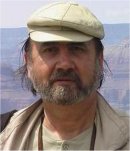|
Plenary
Lecture
Nature-Inspired Intelligent Models for Pattern
Recognition in Environmental Remote Sensing Imagery

Professor Victor-Emil Neagoe
Department of Electronics, Telecommunications,
and Information Technology
Polytechnic University of Bucharest
ROMANIA
E-mail:
victoremil@gmail.com
Abstract: Man has learned much from studies of
natural systems, to develop new algorithmic models able
to solve increasingly complex problems. Enormous
successes have been achieved through modeling of
biological and natural intelligence, resulting so-called
„intelligent systems”. These nature-inspired intelligent
technological paradigms are grouped under the umbrella
called computational intelligence (CI).
On the other side, modern environmental remote sensing
satellite imagery, owing to their large volume of
high-resolution data, offer greater challenges for
automated image analysis. The algorithms are based on
the fact that each class of materials, in accordance to
its molecularcomposition, has its own spectral
signature.Applications are needed both for remote
sensing of urban/suburban infrastructure and
socio-economic attributes as well as to detect and
monitor land-cover and land-use changes.Conventionally,
pattern recognition in remote sensing imagery has been
mainly based on classical statistical methods and
decision theory. Last years, several computational
intelligence approaches have been used with promising
degrees of success in remote sensing image analysis.
This lecture is an approach dedicated to the improvement
and experimentation of several nature-inspired
intelligent models for pattern recognition in remote
sensing imagery. One considers threemain models and
corresponding applications.
First model is an Unsupervised Artificial Immune System
(UAIS), inspired from the vertebrate immune system,
having strong capabilities of pattern recognition. We
have implemented this model for a LANDSAT 7ETM+
multispectral image from the region of Bucharest
(Romania) with four pixel categories (agricultural
fields, artificial surfaces, forest, and water) ; using
UAIS, one leads to the correct clustering multispectral
pixel score better than performances obtained by
applying K-Means and Fuzzy K-Means algorithms.Second
modeluses pixel classification byAnt Colony Optimization
(ACO) algorithm which takes inspiration from the
coordinated behavior of ant swarms. Using the ACO
algorithm to remote sensing image classification does
not assume an underlying statistical distribution for
the pixel data, the contextual information can be taken
into account, and it has strong robustness. The results
of ACOclassification for a Landsat 7ETM+ image
dataset(the same as that used in the first model) leads
to very goodresults. Third modelcorresponds to change
detection using neural network techniques:(a) Multilayer
Perceptron (MLP); (b) Radial Basis Function Neural
Network (RBF) ;( c) Supervised Self-Organizing Map
(SOM). For comparison, one has tested change detection
with statistical techniques (Bayes, Nearest
Neighbor).The data used for the experiments of neural
change detection are selections from a sequence of two
LANDSAT 7 ETM+ multispectral images corresponding to the
region Markaryd (Sweden),acquisitions from 2002 and
2006. Change detection by neural classifiers have led to
better results than those obtained using statistical
techniques.
Brief Biography of the Speaker:
Victor-Emil I. Neagoe was born in Pitesti (Arges county,
Romania) on May 31, 1947.
From 1965 till 1970 he attended the courses of the
Faculty of Electronics and Telecommunications,
Polytechnic Institute of Bucharest, Romania. In 1970 he
received the M.S. degree of diplomat engineer in
electronics and telecommunications as a head of his
series (with Honor Diploma, average of marks 9.97 out of
10). He also obtained the Ph.D. degree in the same field
from the same institution in 1976 (thesis supervisor
Professor Gheorghe Cartianu) as well as the Postgraduate
Master degree in Applied Mathematics and Informatics
from the Faculty of Mathematics, University of Bucharest
in 1981 (average of marks 10).
From 1970 till 1976 he has been an Assistant Professor
at the Faculty of Electronics and Telecommunications,
Polytechnic Institute of Bucharest, branches:
Information Transmission Theory, Television, and Applied
Electronics.
From 1978 till 1991 he has been a Lecturer at the same
Institute and Faculty, courses: Information Transmission
Theory and Applied Electronics.
Since 1991 he has been a Professor of the Polytechnic
University of Bucharest, Romania, where he teaches the
following courses: pattern recognition and artificial
intelligence; detection and estimation for information
processing; digital signal processing; computational
intelligence; data mining. He has been a Ph.D.
supervisor since 1990; he co-ordinates now ten Ph.D.
candidates. He has published more than 120 papers; his
research interest includes pattern recognition, nature
inspired intelligent techniques (computational
intelligence), multispectral and hyperspectral
satellite/aerial image analysis, image compression and
recognition, biometrics, sampling theory.
He has been a Member of IEEE (Institute of Electrical
and Electronics Eng., New York) since 1978 and a Senior
Member IEEE since 1984.Prof. Neagoe has been included in
Who’s Who in the World and Europe 500 . Particularly, he
has been recently included in Who’s Who in the World
2011 (28th Edition) as well as in Who’s Who in Science
and Engineering 2011-2012 (11th Edition).
|
